A common weed growing in the cracks of driveways across the country is capable of relieving pain, calming inflammation and has many other health benefits. Historically, this plant has been considered so valuable that many early settlers carried a piece in their pockets at all times. Many believed that it had magical powers—including the power of granting invisibility.
This driveway weed is chicory, a dandelion-like plant that produces a deep taproot capable of pain relief and healing. Unfortunately, I have never been able to verify the invisibility thing, so don’t expect that magic.
Identifying Chicory
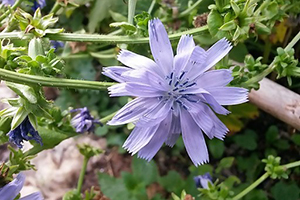 Toothed basal chicory leaves grow in a rosette from the center of the plant. The plant produces a hairy flower stalk which is branched and has a few small leaves. The flower stalk can grow from 2 to 5 feet tall, while the main plant stays close to the ground.
Toothed basal chicory leaves grow in a rosette from the center of the plant. The plant produces a hairy flower stalk which is branched and has a few small leaves. The flower stalk can grow from 2 to 5 feet tall, while the main plant stays close to the ground.
The flowers are attached singly or in groups of two or three in the crook between the branches and stem leaves. They are usually blue, but sometimes pink or white.
Appearing in midsummer, the flower head is 1 ½ inches wide and has 16 to 20 ray flowers. The flowers open in the early morning and close in late morning or early afternoon, sometimes staying open longer on cloudy days.
Related: How To Make Survival Dandelion Jelly with 2 Years Shelf Life
Modern Culinary Use of Chicory
Chicory is often used as a culinary herb and has been cultivated for centuries. The wild chicory growing as a weed in yards and on roadsides across the country is probably descended from early cultivars.
Modern cultivars include radicchio, loose-leaf chicory, root chicory, and Belgian endive. Roasted chicory root is often used as a coffee substitute.
Chicory for Pain
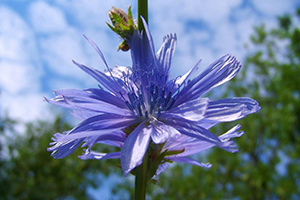 Chicory has amazing health benefits, but one of the most valuable is its ability to relieve pain. However, we rarely see it documented for pain, probably because of the availability of modern pain relievers.
Chicory has amazing health benefits, but one of the most valuable is its ability to relieve pain. However, we rarely see it documented for pain, probably because of the availability of modern pain relievers.
Chicory root has several properties that help relieve pain. It is an anti-inflammatory that relieves pain due to inflammatory conditions in soft tissue, muscle, and joints. It is especially effective against back pain and neck pain caused by stress and tension, as well as arthritis and rheumatism pain.
Inflammation is the main cause of many modern diseases and causes a lot of joint and tendon pain and muscle aches. It causes swelling in injuries and infections. These inflammations are treated by chicory, helping to relieve the pain and, over time, eliminates the cause so that it doesn’t return.
Chicory is also antibacterial and has a slight sedative effect. This adds an extra boost to preventing and relieving pain caused by pressure and infection. The slight sedative effect helps the body relax, which relieves tension pain and stress related pains.
The sedative effect also treats emotional conditions such as anxiety, stress, sadness, and fear, relieving additional causes of pain.
Treating Pain with Chicory
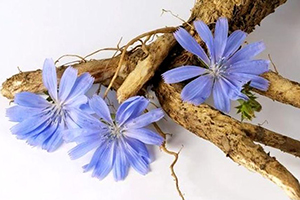 Chicory root works to relieve pain when taken internally or applied externally to the affected area.
Chicory root works to relieve pain when taken internally or applied externally to the affected area.
Chicory root decoction or coffee is effective as a general pain reliever for body aches and arthritis pain.
For acute pain, place 4 drops of Chicory extract under your tongue for fast absorption. It can also be mixed with water and drank. Taken this way, chicory extract acts like ibuprofen to relieve the pain quickly.
For topical use apply chicory decoction directly to the affected area as a poultice or mix 4 drops of chicory extract with some lotion and apply it to the skin above and surrounding the sore area.
Other Health Benefits of Chicory
Chicory has been used as a medicine for hundreds of years, but recently some of its health benefits have been documented by scientific studies. I am linking some of the studies in the list so that you can verify them for yourself, but others also exist. Remember that the lack of a study doesn’t mean that it isn’t effective, it simply means it hasn’t been documented yet. Here are just a few of the known health benefits of chicory:
- Chicory inhibits allergic reactions by inhibiting histamine release and reduces anaphylactic reactions.
- Chicory helps lower “bad” LDL cholesterol levels and decreases serum triglycerides. It also reduces the risk of heart disease.
- Chicory stimulates the growth of healthy gut bacteria, inhibiting cancer and protecting against colon Cancer. It also reduces tumor growth.
- Chicory is a good source of nutrients including the minerals selenium and manganese that regulate the thyroid, immune system, and healthy bones. It is a good source of dietary fiber, vitamins B6, C, and potassium. It is high in antioxidants.
- Inulin and oligofructose in chicory root are beneficial in controlling appetite, obesity and diabetes.
- Chicory improves digestion and keeps the bowel moving properly.
- It prevents heartburn, combats acid reflux and indigestion.
- Chicory is useful in detoxifying the liver and gallbladder.
- It protects the kidneys from stone formation and helps in detoxification.
- Chicory is known to boost the immune system.
- Chicory reduces anxiety, helps the body relax and relieves stress.
- The mild sedative properties of chicory help induce beneficial sleep.
- The extract works as a diuretic which helps detox the liver and kidney.
- Some studies suggest that chicory is antibacterial and antifungal.
- Chicory extracts kill mosquito larva and have been used to prevent malaria.
- And, of course, chicory relieves pain.
How to Harvest Chicory
Hopefully I have convinced you that the chicory growing in your yard is useful and should be encouraged. Your neighbors may disagree but try to educate them on the value of this medicinal crop. Grow some in your garden patch, however. The plants in the driveway may have been exposed to toxins.
Chicory leaves are easily cut off at the base of the rosette during the spring and summer. Young leaves are delicious eaten raw in salads, but older leaves usually need to be cooked to remove some of the bitter flavor. I usually change the water once or twice during cooking, but I strongly dislike bitter flavors. You may enjoy it without changing the water.
To harvest the chicory roots, allow the plant to mature into the second year, then pull the plant up from the roots.
The tap root can go quite deep and you may need to dig carefully around the plant. There are also rootlets growing laterally, so dig around to find them. Leave a few of the roots intact to start a new plant in the spring. The roots can be sliced and dried on a food dehydrator for future use.
Making Chicory Decoction
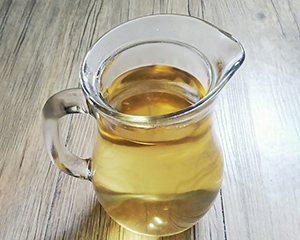 Chicory decoction is like a tea, but perhaps a little stronger. Begin with 2 teaspoons of dried chicory root or leaves. Add it to 1 cup of water and bring to a boil. Reduce the heat to a simmer for 10 to 15 minutes. Strain out the root or herb and drink 8 to 12 ounces per day.
Chicory decoction is like a tea, but perhaps a little stronger. Begin with 2 teaspoons of dried chicory root or leaves. Add it to 1 cup of water and bring to a boil. Reduce the heat to a simmer for 10 to 15 minutes. Strain out the root or herb and drink 8 to 12 ounces per day.
You can combine chicory with other herbs as desired to improve the flavor or medicinal value. Honey is often added for taste.
Related: 10 Most Powerful Medicinal Plants Used by Cherokees
Roasting Chicory for Coffee
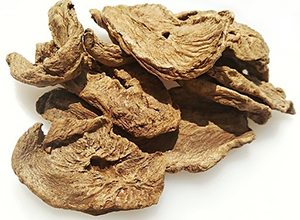
Start by slicing fresh chicory roots into thin slices and drying them on the food dehydrator. If you have dried roots, you can skip this step.
Spread the dried chicory root into a thin layer in a roasting pan or cookie sheet and roast them for 1 to 2 hours at 350 F degrees.
The roasted chicory should be dark brown all the way through. If the center is not dark brown, roast a little longer. The desired color is similar to coffee, or perhaps even darker.
Allow the roasted chicory to cool, then grind it finely in your coffee grinder. Brew it straight, as you like your coffee, or use it mixed with ground coffee beans for a more coffee like flavor. The flavor is different, more earthy and with bright acidity. It has no caffeine, another reason to mix it with coffee.
Store the powdered chicory in a sealed jar in a cool, dry place.
Cautions on Chicory Use
Chicory root is considered safe and most people tolerate it easily. However, some people are allergic to it and can have a reaction. Do not use chicory if you are pregnant or breast feeding. It can bring on menstruation and cause a miscarriage.
The health benefits of chicory are substantial and it is definitely worth keeping around. If you decide to harvest it from wild plants, choose secluded plants away from exhaust fumes and other potential environmental toxins. Ideally, plant a patch in your herb garden or in a deep container. It is edible and medicinal, so it definitely deserves a place in your medicinal garden.
You may also like:
53 Plants & Herbs You Can Propagate From Cuttings
10 Medicinal Seeds You Should Hoard (Video)
5 Herbs That Will Relieve Your Joint Pain
7 Things I Wish I Knew Before Going Off the Grid
Similar to Morphine: The Best Natural Painkiller that Grows in Your Backyard

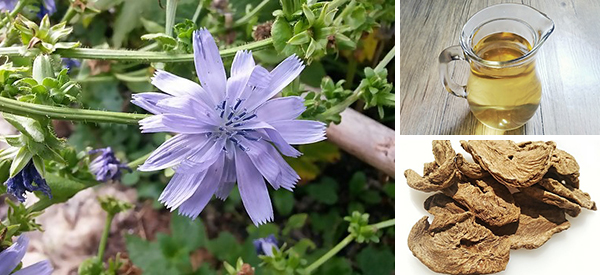














I have never seen this growing where i live in N.W. Louisiana. Can you buy seeds and where?
look by railroad tracks, road side and ditches to start then once you see it a few places you will see it others.
Excellent article, Diane. Had no idea chicory was THAT useful. The only thing I knew about it was that Chicory could be used as a coffee substitute. Thanks!
I use a tincture that I buy, but didn’t know that was good for all of this. I will look in the Spring for the plant. I do not put any fertilizer on my property or chemicals of any kind. I like it when deer come up and eat my grass and plants. I figure it is one place they won’t get the bad stuff.
How do make Chicory extract?
ronnie go back and slowly reread the article writen on how to then reread it till you understand it please
Article stated how to make a decoction which sounds more like a tea to me. An Extract is usually higher potency and lots of times involves the use of vodka. The author doesn’t state how to make the extract and I don’t think 4 drops of this decoction is going to relieve any pain.
From the WEBMD website:
“Overview Information
Chicory is a plant. Its roots and dried, above-ground parts are used to make medicine.
Chicory is used for high blood pressure, heart failure, loss of appetite, upset stomach, constipation, liver and gallbladder disorders, cancer, and rapid heartbeat.
Some people apply a paste of chicory leaves directly to the skin for swelling and inflammation.
In foods, chicory leaves are often eaten like celery, and the roots and leaf buds are boiled and eaten. Chicory is also used as a cooking spice and to flavor foods and beverages. Coffee mixes often include ground chicory to enhance the richness of the coffee.
How does it work?
Chicory root has a mild laxative effect, increases bile from the gallbladder, and decreases swelling. Chicory is a rich source of beta-carotene.
Uses & Effectiveness?
Insufficient Evidence for
• Osteoarthritis. Early research shows that chicory root extract does not improve pain and stiffness better than a “sugar” (placebo) pill in people with osteoarthritis.
• High blood pressure.
• Heart failure.
• Constipation.
• Liver disorders.
• Gallbladder disorders.
• Cancer.
• Skin inflammation.
• Loss of appetite.
• Upset stomach.
• Other conditions.
More evidence is needed to rate the effectiveness of chicory for these uses.”
From Organicfacts.net:
“Side Effects of Chicory
Although there are many benefits of using chicory for your health, you should not consume it in excess.
If you are pregnant there is a possibility that it can stimulate menstruation and possibly lead to a miscarriage.
Also, women should not eat excess chicory while breastfeeding, since there is a lack of research done on the transfer between mother and child through breast milk.
Furthermore, this plant is closely related to ragweed, marigolds, and daisies, so allergic reactions are not uncommon, especially, if you are already allergic to these species.
It is advisable to consult your doctor whenever you add something new to your diet. Finally, if you have gallstones, too much chicory can exacerbate the problem, so be sure to speak to your doctor if you have had gallbladder issues in the past.
Other than that, enjoy this food in your coffee, or whatever other preparation brings you all of these wonderful benefits!”
Yes! I love the stuff. I had 4, yes, 4!, plants survive summer. If you think that strange (some areas it’s so common, farmers call it the blue devil weed), people claim I’m the only one in the area (Zone 9, semi-desert) who ‘knows’ how to raise it. Of course, ground squirrels burrowed under it, and the dog went a-huntin’, and now some of it’s potted and hoping for a hard freeze or two. Wow, be cool if it finally bloomed. And, what is in the garden is the Italian version, which tolerates drought. In the kitchen, several pounds of roasted chicory that can be used like coffee, and from now on, a little will go in each pot. A good source is Luzianne Coffee, which is chicory and a lot of stores carry it.
How do you make an extract? Will it work for menstrual pain?